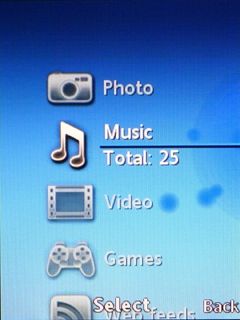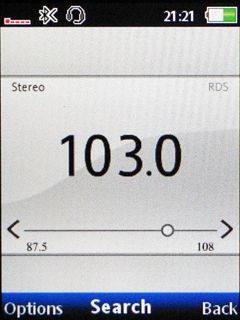Why you can trust TechRadar
Proving that media is central to the Sony Ericsson Zylo, there's a softkey to the Media app from the Home screen. It brings up a scrolling interface that has clearly taken its cues from Sony's XMB, but doesn't use it outright, like the Aino.

From here, you can access photos, music, videos, games and even web feeds via RSS (which can be added from the browser). Each of them reveals more options when you go in, tying together some of the other apps on the phone.

For example, the photos menu includes options to browse your stored albums, as well as a link to the Photos tab in the Facebook app. The videos menu offers your stored videos as well as a link to the YouTube app.
All of the media playing options include a link to the PlayNow service, in case you're desperate to spend some money on new content.
Oddly, the music menu doesn't include a link to the TrackID song identification app. Seems like an obvious addition to us, but there you go.
For a handset that's focussed so heavily on media playback, we're just astonished at some of the short-sighted decisions made in the Sony Ericsson Zylo.

It really comes down to the phone's unique selling point: FLAC support, or the half-baked introduction of it, anyway.
FLAC stands for Free Lossless Audio Codec. It's an open source audio format capable of extremely high-quality sound reproduction.
Let's be clear: we're totally behind the introduction of higher-quality audio on mobiles in general, and that goes double when it's a phone with the Walkman brand behind it.
But you have to do it right. Lossless audio carries different requirements than what you usually stick in iTunes, but nobody seems to have told Sony Ericsson.
Lossless files tend to be at least ten times larger than their lossy version – we could be talking up to 100MB per song. This is fine – the phone supports microSD cards up to 16GB, so you can still fit a few albums on there. Except, of course, that none is supplied.
Okay, yes, in a mid-range handset we have no divine right to a large amount memory, but if you're going to make a big deal of playing lossless audio, it would be polite to include enough memory to hold more than two songs.
Which brings us neatly on to the lack of USB cable. Without this, how does Sony Ericsson expect us to get the songs onto the phone? Bluetooth? We tried that – it works, but it takes 10 minutes. Per song.
Maybe when we go out to buy our microSD cards, we're also expected to pick a card reader. Okay, fine – then don't hide the microSD card under the battery cover! Make it easy to get to, if we're supposed to have it in and out whenever we want to add songs.
Last in this rant is the proprietary headphone connector (and the supplied model), which is the most inexplicable part of it all.
"Best sound quality ever on a mobile phone" is what Sony Ericsson says about the inclusion of FLAC. We're inclined to believe them, but who could ever tell using the cheapo bundled earphones?
They're not the worst around, but without a 3.5mm jack, we're stuck with them, rather than much higher-quality cans for the higher-quality music we're playing.
Fortunately, we at TechRadar have a magical drawer full of every cable known to man. It's like the Room of Requirement in Harry Potter, provided your only requirements are obscure gadget connectors and strong Portuguese liquor.
From it, we fished out an adapter we had handy from an old Sony Ericsson Walkman phone that enabled you to plug 3.5mm headphones/speakers into the proprietary port. Just the sort of thing it might be nice to bundle in with your new phone that features super high-quality audio, eh?
Unfortunately, it turned out that our troubles with testing the quality of audio playback weren't finished yet. We loaded on our first FLAC tester song and hit play. We got only an error message.
This was a song converted from an Apple Lossless codec file, and it clocked in at 90MB. We figured that might be asking too much of the Zylo, so we instead ripped a CD with the FLAC settings set to make it the smallest file possible.
This time, we were getting 30-40MB per song, and these worked just fine. We then loaded on MP3 versions of the exact same songs, which were all 3-4MB each.
Honestly? Underwhelming. We think the FLAC file had slightly more clarity to both the bass and vocals, but in most songs we couldn't tell the difference.
We actually tried a blind listening test, and we really didn't know which was which, generally (we got some right, but then we did have a 50/50 chance). That didn't really change when used our special adapter to hook up to a nice set of speakers.
Audiophiles even more serious than us may pick out points that make it worthwhile for them, but for everyone else, we'd suggest that this isn't going to revolutionise the way you listen to music on your phone.
Our guess is that Sony Ericsson haven't improved on the audio decoding chip in any way, leaving high quality music to be squished and downgraded on its way out the earphone socket.
For most people, we think the ability to carry ten times as many songs is going to have more value than an almost imperceptible increase in audio quality.
The music player is okay to use, but we weren't blown away by it. Browsing your songs is easy enough, and you can access settings like the equaliser on the fly.

It worked, and is fairly intuitive, but it sets no new standards for music players on phones. Aside from FLAC, it also support MP3, AAC and WAV files.
The YouTube app is similarly easy to use. It's not great if you just want to hang out among the videos and watch nothing in particular – though there are options for Most Viewed, Top Rated and Most Recent – but if you're looking for something specific, you won't be disappointed.
You can send your own videos to YouTube straight from the video media menu. In both this case, and watching videos generally, the lack of Wi-Fi can be a bit of an issue.
Unless you've got very consistent 3G signal, you could find videos stuttering. Similarly, uploading videos has the potential to be a nightmare unless you're confident you've got a strong, steady 3G connection.
Video quality is boosted by the screen's lovely colours, but videos with any significant movement suffered from an awful lot of motion blur. Fine for the occasional YouTube jaunt, but this is definitely not a movie-watcher's phone.
You can load and watch movies in MPEG4, H.263 and H.264 formats.
The Radio app requires the included headphones to work, as is the norm. Hook them up and you can either scroll through the frequencies yourself, type in a specific frequency or use the 'Search' function.

At first, we thought the search didn't work because nothing happened for a few seconds, then it suddenly skipped forward and settled on a signal. Basically, it doesn't actually register that you've pressed the button, or tell you that it's searching, until it finds something.
It's fine once you realise that's how it works, but a little bit of UI feedback wouldn't go amiss. The clarity of the radio was good enough for a little bop along, but was no substitute for the built-in music player.
The TrackID function for identifying playing music and taking you to buy it, is built-in to the Radio app, so there's no more waiting for the DJ to tell you what song was. In theory.
In practice, it identified nothing for us. Even with the clearest radio signal we could find, we got total rejection.
Current page: Sony Ericsson Zylo: Media
Prev Page Sony Ericsson Zylo: Camera Next Page Sony Ericsson Zylo: Battery, connectivity and apps
